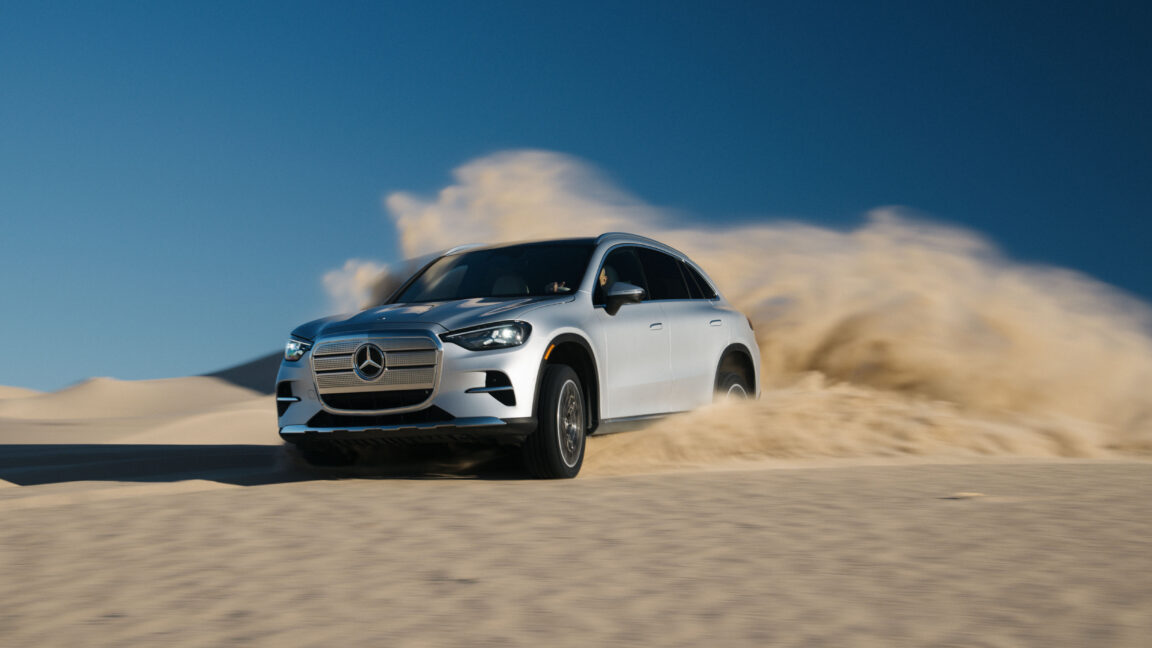
Credit: Mercedes-Benz
LAS VEGAS—About 100 miles from Las Vegas, at the northern end of the Mojave Desert, you’ll find a pretty large pile of sand. The Dumont Dunes formed thousands of years ago as sand from recently dried-up lakes blew in on the wind through gaps in the mountains. We’re talking real Lawrence of Arabia stuff—some dunes hundreds of feet high, and a large amount of it is run as a recreational area by the Bureau of Land Management for activities that include a bit of off-roading.
Which is why we found a trailer full of Mercedes-Benz engineers and some preproduction prototype electric GLCs at work out there. When we last saw the next GLC, it was earlier this year at a German test track, wearing one of those black-and-white digital camouflage wraps that obscure the finer details of a new design. The automaker is dealing with the finishing touches ahead of the model going into production next year. The hardware is signed off on, but there’s plenty of code to tweak and calibrations to perform, including making sure that even when the terrain gets loose, the handling won’t.
While I’m sure that the vast majority of GLC customers’ experience with rough surfaces won’t extend past the odd, particularly bad pothole, the car is being engineered to cope with much more. When fitted with the optional air suspension, the ground clearance can increase to up to 8.1 inches (206 mm) at low speed and 7.2 inches (183 mm) even up to highway speed, as long as the car is in the more extreme of the two Terrain modes. That allows for approach and departure angles as much as 21.4 degrees (approach) and 22.6 degrees (departure).
Unlike a conventionally powered 4×4, the front and rear axles here are not connected by anything other than the GLC’s electronic network. But the absence of a center differential is no bad thing here. Sensors constantly monitor each wheel, determining how much traction is available at each corner, apportioning torque from the front and rear permanently excited electric motors as needed, much faster than an off-roader with an internal combustion engine could. (While the car can decouple its front motor for better efficiency on the road, it’s always engaged in Terrain modes.)
The reason Mercedes’ engineers were driving up and down and across the dunes was to work on the car’s brake control systems. As you slow with the brake pedal, the car’s electronic brain juggles the input of the traction control, electronic stability control, antilock brakes, and a downhill speed governor that keep you going where you want, as opposed to careening down a slope at speed.
After a passenger ride through a particularly tricky section, it was my turn to have a go. It was a more surreal experience than messing around in an all-wheel drive car on fresh snow—that might involve low traction surfaces and some sliding around, but the horizon tends to remain in the same place.
As I climbed a dune, my view was nothing but sand, then the deep blue sky. Despite the steep slope and the fact that the car was shod with regular street tires, the wheels found traction where needed, “churning” where necessary. Under braking, the ABS allows the front wheels to remain more controllable, taking into consideration any steering angle you have.
And that may be a lot, because as Lightning McQueen learned in Cars, to go left, sometimes you have to turn right. At times, crabbing up the side of a dune involved making progress with a fair amount of opposite steering lock.
Driving on a loose surface like sand, similar to driving on snow, requires a fair bit of torque, and the GLC’s 596 lb-ft (808 Nm) was more than enough to throw a rooster tail or two as the speed picked up and propelled us along. And the low center of gravity that results from the 94 kWh battery pack between the axles no doubt helped keep the car planted even while driving sideways along the dune.
My experience was much less repetitive than that of the Mercedes engineers, whose job it is to go out and drive a route, come back to the trailer, download the data, and upload a new configuration to the car. Then go out and drive the route again and repeat the whole process before driving two hours back to Las Vegas at the end of each day. But the result should be an electric SUV with the kind of mountain goat ability that belies its posh badge and looks.
The new GLC with EQ Technology goes on sale in the US late next year.

-
 C114 Communication Network
C114 Communication Network -
 Communication Home
Communication Home


